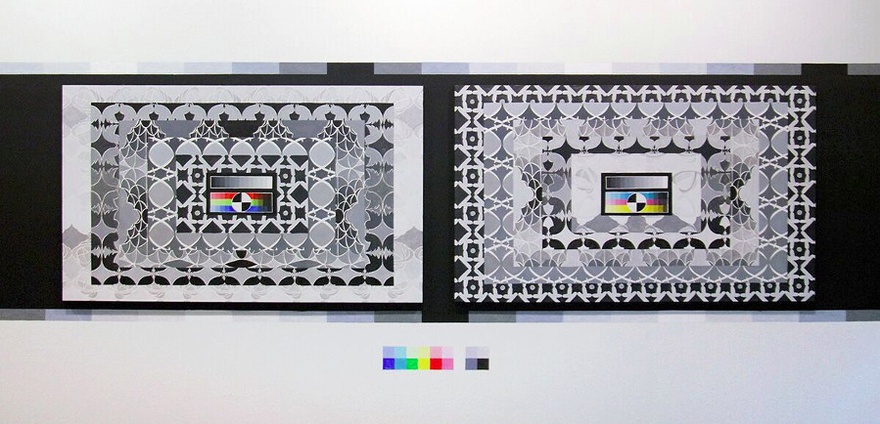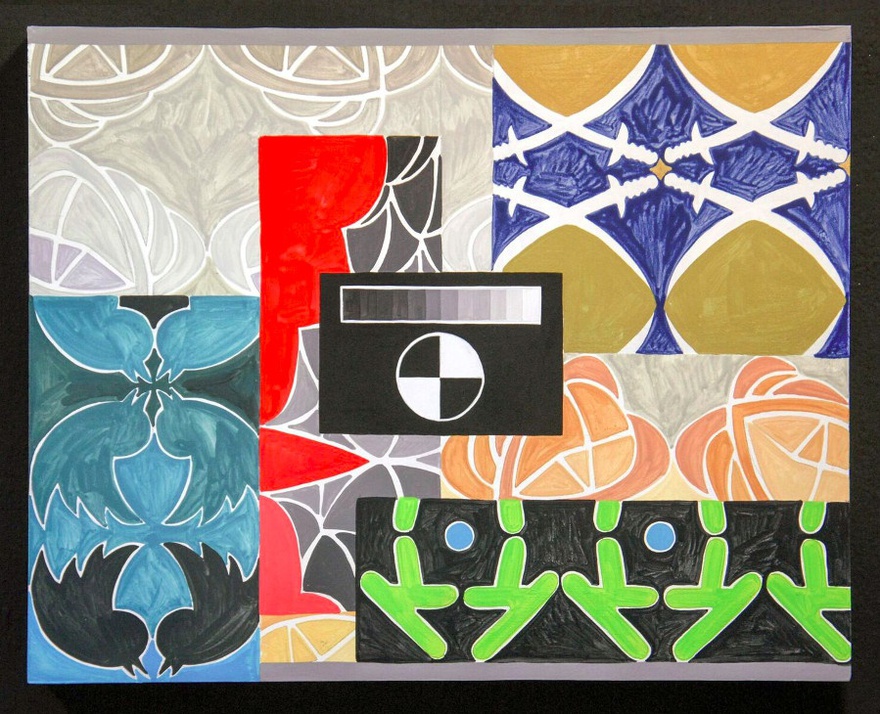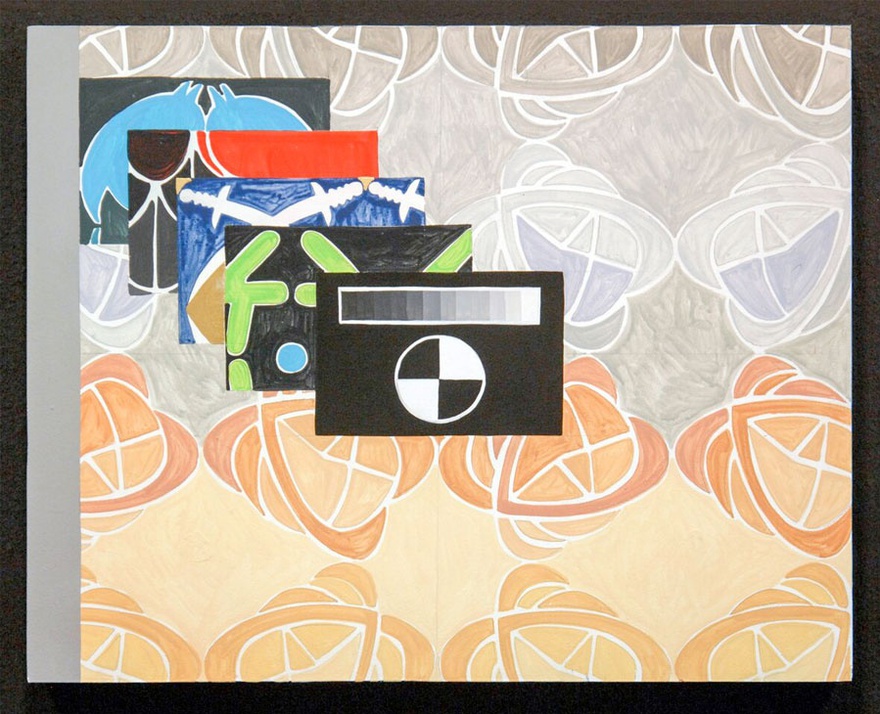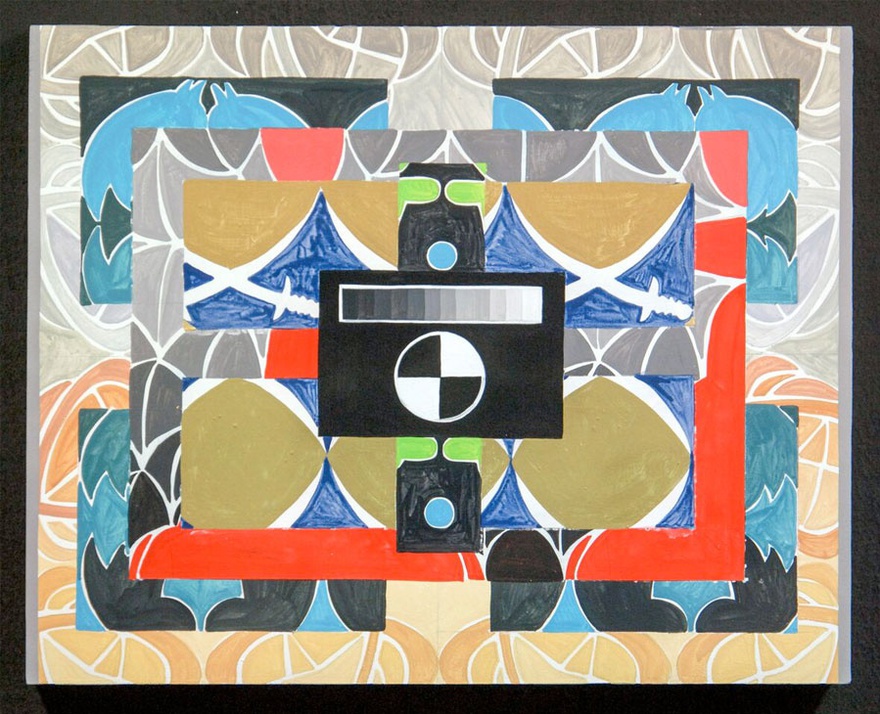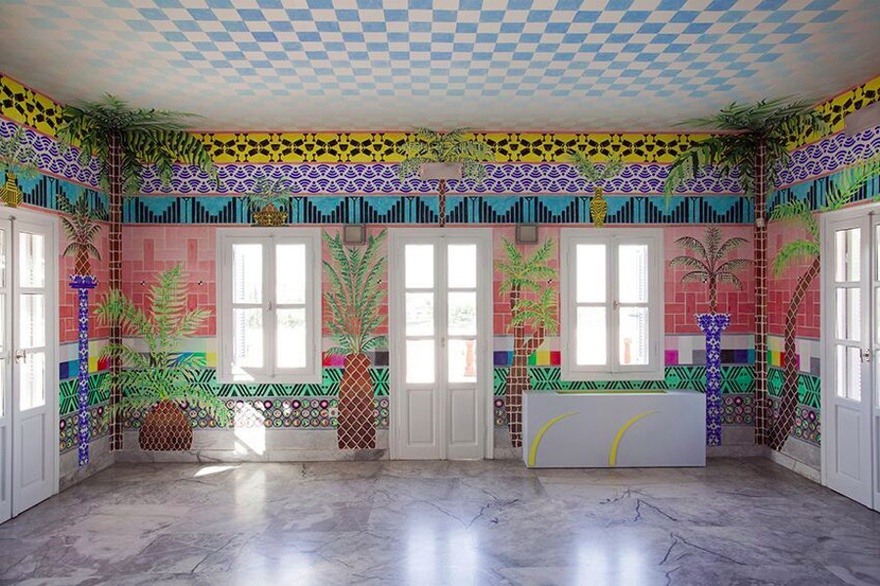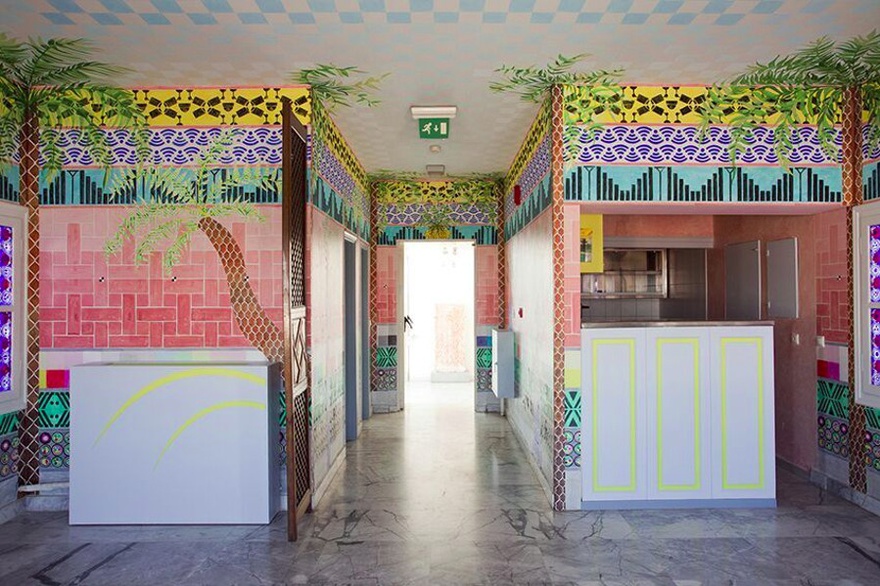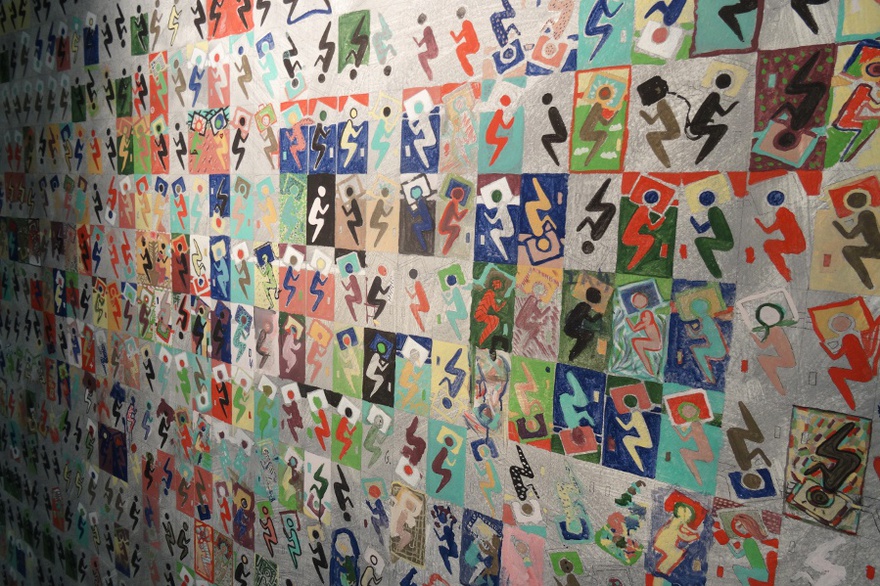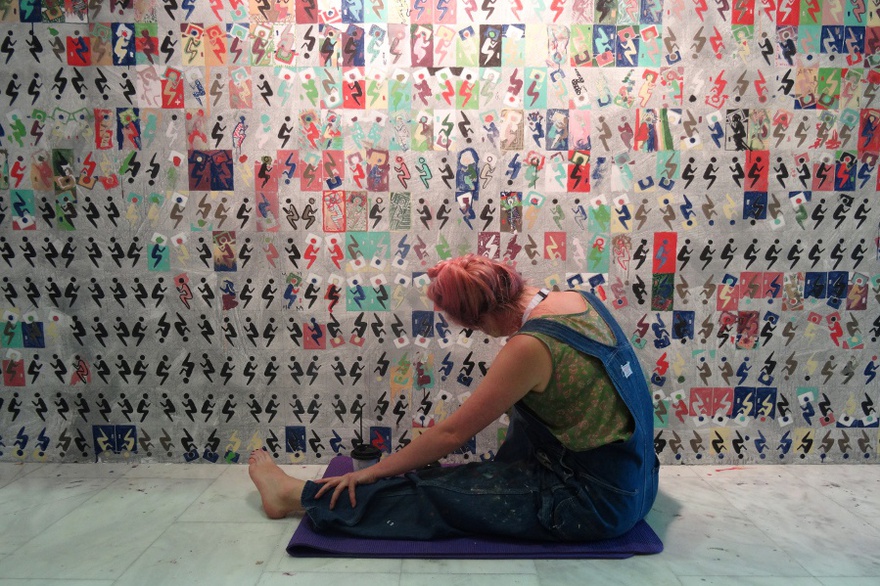Interviews
Information Acts
Navine G. Khan-Dossos in conversation with Stephanie Bailey
Navine G. Khan-Dossos uses painting to explore 'the algorithmic nature of the interconnected world we live in' by melding geometric abstraction with traditional aniconism of Islamic art, and the patterns underpinning digital life. This is a reflection of the artist's educational background: Khan-Dossos studied Ottoman art and architecture at the University of Cambridge, Arabic at the University of Kuwait, Islamic art at the Prince's School of Traditional Art, and fine art at Chelsea College of Art and Design. Having fused these studies into her practice, Khan-Dossos approaches painting – from egg tempera on wood panel, to wall works and murals – as an 'informational' act in which fields of knowledge are both abstracted and built from 'the conflicted and complex relationship of Islam to the West'. In recent years, this has led to a particular focus on the aesthetics and politics of Islamic State digital propaganda, which Khan-Dossos sees as a means to 'invest in finding a new language that reflects the patterns and connections that underpin these images and generate them in the digital world'. The artist elaborates on this research in this discussion, which starts with the artist's Ibraaz 010 project commission: an online PDF that forms the digital component of the artist's exhibition, Command: Print (2016), at NOME Gallery in Berlin.
Stephanie Bailey: I wanted to begin with Command: Print, your exhibition at NOME in Berlin, which presents 36 new panel paintings based on pages of the online Islamic State of Iraq and Syria's (ISIS) propaganda magazine Dabiq, which you turned into geometric paintings. The installation of these panels at the gallery mimics wall shelves on which entire magazine layouts are presented and worked out using page print outs: a reference to a fashion magazine, where you interned for a time in 1997. As part of the exhibition, you have also created an Ibraaz project, for which you reconstituted these 36 painted panels into a PDF magazine that is available online for download.
Could you talk about the loop the exhibition produces, from the original source material, your abstraction of it, and your reconstituting of this abstraction back into an online, distributable form?
Navine G. Khan-Dossos: The first thing I noticed when I started looking at Dabiq as a way of interacting with ISIS propaganda was the troubling pseudo-slickness of it. It has a particular style and a traceable lineage through other similar publications such as Al Qaeda's Inspire magazine, and others further back. The format made me wonder what an issue would feel like in one's hands and what the print-run would be. The fact that Dabiq, by its very nature, is an online publication that exists only in digital form allows for an extraordinary reach of distribution – it is also available in several languages. This means that someone like me can read it and get a sense of the shape of this propaganda machine, albeit through certain channels such as clarionproject.org rather than downloading or printing it.
The PDF format I have created maintains the A4 fixed-layout-flat-document-format despite the fact that it is unlikely to ever be printed out. For me, this straddles two worlds: that of the physical and that of the digital. In this work, it is the physical that I am trying to grapple with – imagining the room where the magazine layout and editorial meetings happen; how the pages are presented and in what order; and the desk where the files are formatted and sent out into the world. The only memory I have from doing teenage work experience on a magazine was the great long back wall of the open-plan office where narrow shelves supported foam-core mock-ups of each spread, so the editorial team could shuffle around the content and see what it looked like as a whole entity. In my mind, and in the exhibition space at NOME, I tried to imagine this space existing somewhere in Raqqa, for instance, although it is more likely that it is not in Syria at all, and the team shuffling the content around, working out which report on the destruction of monuments should come first, or where to place the interview with John Cantlie in relation to the claims made for ISIS involvement in the Paris bombings.
SB: How does this influence the way you consider ISIS through your work?
NGKD: The territory of ISIS is not just a geographic location; it exists as a cyber-caliphate. The intention is not to infantilize the process or condone the content, but to return some matter and solidity to the issue at hand, which we experience in great part through the digital realm. This physicality and solidity extends from the magazine mock-ups to the people who create them and those at the other end of this communication.
The layouts I create as geometric paintings work with the graphic design of each page using the grids, columns and compositions from real Dabiq pages. And while the original article titles often become the titles for my work, I see no need to reproduce either the original text or images contained within their pages. This can easily be found online by anyone curious enough to investigate it, but I see no value in reproducing this content in my work. For Ibraaz, the 36 paintings are reconstituted into a downloadable PDF, bringing the work full circle from its precarious origin as illegal material that may or may not be widely available in years to come. This work will remain; leaving a trace of the original documents in a form that presents new terms of engagement and framing.
SB: Could you elaborate on what these new terms of framing or engagement might be, or how you formally engage with such terms through your work?
NGKD: I'm very interested in the roots of words connected to publishing, both online and in print, and how these interact with the politics of Dabiq. The English and Arabic words for 'cartridge', 'calibrate' and 'magazine' have shared origins in military terminology. For instance, 'calibration' comes originally from the Arabic qalib, 'a mould for casting'. The Arabic term was also used in the sense of 'mould for casting bullets', which is the oldest literal meaning in English. The meaning of the word as the 'inside diameter of a gun barrel' begins in the late sixteenth century. 'Magazine' also has late-sixteenth century roots: a 'place for storing goods, especially military ammunition', coming from the Arabic makzin through to the Middle French magasin 'warehouse, depot, store'. This original sense is now almost obsolete, but its reading as meaning a 'periodical journal' dates from the publication of the Gentleman's Magazine in 1731, which was so-called from an earlier use of the word for a printed list of military stores and information or, in a figurative sense, from the publication being a 'storehouse' of information.
SB: How does this feed into your practice in general? I'm thinking of your exhibition The Black Standard (February–March 2016) at Galerie Roger Katwijk in Amsterdam for which you presented paintings created through an interpretation of the black banner and its legacy, which is said to have been made from the cloth of the prophet's wife Aisha's headscarf and flown by him, and that has more recently been adopted as the flag of ISIS. The project takes, as you describe it, 'the diagrammatic and compositional elements' of the flag, considering 'the relationship between its geometry and text, its history and use of black and white'.
NGKD: My first real research and work looking at ISIS came with the execution of James Foley in August 2014. I had just finished a series of works looking at the Innocence of Muslims (2012), a 14-minute film 'trailer' with a particular interest in the role of green screen in the creation of Orientalist landscapes in contemporary extremist representations of the Middle East. The video caused a great uproar, both on- and offline, in 2012, and there were several protests and attacks in many countries, including Egypt and Libya, in which protestors directed their anger regarding the blasphemous nature of this low-budget pseudo-film trailer towards the local American embassies. The impact of this badly made agitprop marked a turning point in my interest in home grown and organizational propaganda that uses technological advances to suggest authenticity or quality.
With this in mind, I was amazed and fascinated by reports suggesting that the high production quality of this execution video had made some believe that it was in fact faked, using special effects and dubbing to produce the desired outcome. While this has been almost unanimously proved not to be the case, this new era of violence being filmed from multiple angles and edited into a timeframe that keeps the viewer engaged made me think differently not so much about the content but its packaging. I started to notice the presence of the caliphate flag in the top right hand corner of many ISIS videos: the black standard. For me this became a calibration target through which all material produced by ISIS could be standardized, processed and released in the name of the cause. The flag has its own long and complex history, but in the hands of ISIS it has become synonymous with the group, both in Syria and Iraq, and in the videos of lone wolves, printed out at home on desktop inkjets, and pasted to the back wall as a backdrop for martyr's videos.
SB: How does this relate to the quote by Jonas Staal that you use in the project's introduction? 'The black square of the Islamic State is the image that forms the beginning and end of the ever-expanding caliphate. The image that comes before and after all others: the end of the immoral image feed of Western heresy, and the return to the origin of the world and the Prophet's word (not his image).'
NGKD: Within western art history, the black square has very different revolutionary connotations. It is the beginning and the end of the image, and Staal's piece touches upon this but brings it back to the place of the news feed scroll rather than above the door lintel in a Russian home. But I find the identification with the calibration image for an RGB screen all the more fitting. It isn't just aesthetic: it is functional. It is the image before the real image can be registered and it is what remains after it. Without it no standard for colour, or lack of colour, is possible. No image is legible.
Working through the functional colours, calibration targets, symbols and graphic design layouts of ISIS is a way of interacting with the material reality of this phenomenon. It is a way of breaking down something that can often feel insurmountable and unknowable, and therefore impossible to make work about. These reductions are not altogether abstractions so much as distillations; looking for the pre-image and the post-image when the actual image is too horrifying to look directly at.
SB: Could you elaborate on how the flag acts as a calibration target for each painting, while taking into account the process of making these paintings?
NGKD: I talked a bit about this calibration of the screen earlier, but it is important to address its role in a painting, too. Much of my palette is derived from what I think of as a functional colour: RGB, CMYK, grey scales and white balances. These often take the form of calibration targets from colour cards painted into the works themselves, presenting not only the work but also the means of reproduction for that work. When an artwork or archaeological object is photographed, a small colour bar is inserted into the frame so that any colour corrections can be done based on those principle values presented on the card; namely RGB, CMYK, and so on. By painting these into the works there is a suggestion that the work is in some way self-conscious; aware of its own reproducibility and representation through different media other than its physical form. It defines itself or provides the means of calibration ahead of any future act.
In the same way, the black standard inserted into the frame of an ISIS-affiliated video or still image presents a stamp of origin and authority – a way of calibrating that image not to a colour value but a political and moral position. Much of ISIS's material is produced in a self-knowing way, with the knowledge that it will be endlessly reproduced online within its own organization and by foreign media. It is often made with this multiplication in mind, but that little flag or symbol in the top right hand corner serves as a thread of continuity through that ever-changing output.
SB: Did you think about the punk band, Black Flag at all?
NGKD: Not as much as I should, although I often think about Crass and their band logo.
SB: You have said that you purposefully use an 'analogue' methodology, suggesting a historical lineage from the Quattrocento, and explicitly circumnavigating oil paint altogether. Could you expand on that?
NGKD: I've never really been interested in working with oil paint. So much of its value – in its history and contemporary use – is about generating depth by building up layers over time. Firstly, I don't have the patience for working that way, but also I enjoy the opacity and 'matte-ness' of gouache in particular. Although it does feature in western art, gouache's origins can be traced back to ninth-century Persian miniature painting, from where it spread westwards by the fourteenth century, so it has always had strong associations with Islamic manuscripts. In the industrial age gouache becomes a cheap and cheerful poster paint, often used in advertising as a way to generate images that would then be reproduced. There was no need for pigments to have lightfastness as the original poster image made by the designer would soon be discarded whilst the reproduction would live on in print. So these two distinct historical moments both draw down into the way I use the medium and its associations.
I rarely use more than one layer of colour in all my work, and this thinness is derived out of a fascination with, and desire to mirror, the liquid crystal display through which we interact with many aspects of the world on screens. So much information goes into the creation of images but what we are finally presented with are a series of pixels across a thin-film transistor. All we interact with is the skin.
SB: And how do you relate with aniconism in your work and the question of representation?
NGKD: Aniconism is something I often use as a go-to word to describe the essence of what I'm trying to paint, or not paint, but it's not really such an easy word to unpack. There are a lot of misunderstandings about figuration in Islamic art, and whether this produces an 'abstract' art in the absence of these forms. The Qur'an does not explicitly condemn the depiction of human figures, but like the Abrahamic tradition before it, it does condemn idolatry. This is particularly important in places of worship such as the mosque and the Ka'aba in Mecca, where the emphasis is on the spoken and written word rather than the illustrative image. The absence of icons in this religious environment – Aniconism – therefore generates a space that is summed up well by a thinker I read a lot in my early twenties, Titus Burckhardt. He was a writer with a great knowledge of Islamic art and Sufi poetry and one of the founders of the 'Traditionalist School' of twentieth-century authors. In Mirror of the Intellect: Essays on Traditional Science and Sacred Art (1987), he says:
By excluding all anthropomorphic images, at least within the religious realm, Islamic art aids man to be entirely himself. Instead of projecting his soul outside himself, he can remain in his ontological centre where he is both the viceregent (khalîfa) and slave ('abd) of God. Islamic art as a whole aims at creating an ambience which helps man to realize his primordial dignity; it therefore avoids everything that could be an 'idol', even in a relative and provisional manner.
This was very much the philosophy of the traditional training I followed for a while. But I always found it difficult to get a proper footing in this approach given my work was not 'Islamic' so much as working within the strictures of an Aniconic practice. It also wasn't allowing me to fully express the politics of my research and work. That is until I stumbled across the writing of Laura U. Marks, whose book Enfoldment and Infinity fundamentally shifted my relationship to Islamic art and its possible engagement with the digital.[1]
SB: This relates to the contemporary, algorithmic digital world you conjure in your paintings.
NGKD: Marks' basic premise is hinged upon the following:
Both new media art and Islamic art are, broadly speaking, aniconic. Art is aniconic when the image shows us that what we do not see is more significant than what we do. In both Islamic art and new media art, the most important activity takes place at a level prior to the perceptible image. The image that we perceive refers to its underlying cause – in ornament, geometry, pattern, text, and code-generated images. These are not artworks of the image but […] of enfolding and unfolding.[2]
I read this book in 2011 as I was watching the many 'Springs' across the world take shape through my then-Blackberry handset. It was a difficult time of being a passive viewer to a changing and abortive world in pain and that yet remained hopeful. It was mesmerizing and profoundly disturbing. I could no longer make the work I had been making. As I watched and perpetually refreshed my smartphone there was still a noticeable moment between the calling up of an information search and its display; this often took the form of the grey and white checkerboard, a holding page from which the image or story finally emerged. This space between the requesting and receiving of an image seemed to speak directly of this enfolding und unfolding – of the geometric grid upon which we momentarily project what we hope or fear to see next.
And so all my paintings then became these checkerboards that freed me from everything that had gone before, and allowed something simpler and more universal than Islamic geometry, the digit, and the pixel to become the beginning of new forms that could be mine and not part of a grand narrative of cultural appropriation. The paintings remain aniconic but are now presenting the building blocks of the contemporary image rather than images themselves. Those forms vary from green and blue screen paint, Photoshop checkerboards, CMYK printer cartridges or RGB calibration targets. All suggest an image to come or that has passed by, but was never the thing itself. This became my form of aniconism.
SB: All of which relates to a recent project you staged in Athens, Greece, at the Benaki Museum of Islamic Art: Imagine a Palm Tree (2016). Could you talk about this project and how it relates the history – and erasure – of Orientalism in Greece to a palm tree?
NGKD: Imagine A Palm Tree is a wall painting, and follows on from a project of recent years that seeks to make site-specific works rather than canvases. It is fundamentally about Athens and the place of the palm tree in its landscape. The tree acts as a symbol or allegory for the Orient through its absence or presence in the capital.
Some say the palm trees of Athens were originally cut down by order of King Otto in the mid-1830s so that his new capital would look more European and less Oriental or, more specifically, North African. The palms have since been through various phases of replanting and culling since then, with the most recent phase taking place during the 2004 Olympics, when the import of the trees was intended to give a look of luxury more than Orientalization, although these are obviously intertwined somehow.
Imagine A Palm Tree was a way for me to navigate the many histories, politics and narratives of the city with a particular emphasis on the idea of identity. Having only recently arrived in Greece, it was clear that yet another period of self-definition is in process, another moment of orienting Athens towards or away from Europe. And from this comes important questions of self and other, difference and unity, sameness and exoticization. There was a lot to process after the three months of installation and three months of events. But one of the most important things I took away from the experience was that the project allowed me to think about a mural in three distinct phases: performance, presence and place.
During the first phase the museum was open during the whole three-month installation process, so visitors were able to come in and watch the work in progress and talk to me about it and their own experiences of losing a palm tree to disease in their family home or remembering their first visit to see the Washingtonia palm colonnade at the National Gardens in Athens. This had a huge impact on the direction of the work as I left it open enough to be able to react to these conversations and turn that material into visual forms.
The second phase was the finished painting and the space of the café being re-opened again as a business. Having been closed for six years, it was a very positive outcome of the commission that the room was once again being used as it was originally intended and that visitors were coming to see the museum but also taking some time to be present within the painting itself, whilst taking a coffee or lunch. I like the idea that the work is experienced as an ongoing environment that opens itself up to the viewer over a prolonged period. There is so much going on in the painting that it takes a while to sift through the layers of colour, technology and symbolism.
The third part of the project was a series of talks and events hosted in the space, bringing together different speakers on the subject of the palm from different areas of interest. These included the president of the Greek Palm Tree Society and the director of the National Gardens, James Bridle, discussing the vertical city, trees as cell phone towers and the surveillance of the Olympic Games of 2004, and Metasitu (Liva Dureva and Eduardo Cassina) presenting the Dubai Palm Islands as an oasis and state of exception. The painting became a canopy under which all of these discussions could take place and engage new and diverse audiences.
SB: You also worked actively with and on migrant issues during in your time in Greece, both as a volunteer and, more recently, as an participating artist at Art Athina, staged at the Taekwondo Stadium in Athens, which acted as a shelter for migrants. Could you talk about that?
NGKD: Being in Athens, it is evident how much grass roots activity is taking place in the city, dealing with the influx of migrants and refugees, both those passing through and those who can't go any further. It's incredible to see what groups like Notara 26, among others, are doing in terms of providing shelter, food and support to families and how this has changed and expanded as the demand has shifted. The Silent University, spearheaded by Ahmet Ögüt, is also providing an important platform for solidarity and the sharing of knowledge. There is always a possibility to be part of these structures and help in any way one can, and finding that space is easy if you want to help out. So I have been engaged in the ways that I can help through art sessions and I will be providing more structured workshops in the future.
This experience provided me with a rudimentary backbone of understanding that was formalized in a recent project Capacity, presented at Art Athina held in the Taekwondo stadium in May 2016. Since November 2015, the Macedonian border has been strictly controlled, only giving intermittent passage to Syrians, Iraqis and Afghans. With the rollback of those unable to pass back into the capital, the Olympic Taekwondo stadium was used for a limited period in December 2015 to receive those unable to find shelter in the city in the winter months. In an interview, camp manager Panos Koutsianas said the building's maximum capacity was 1,700, but he wanted to keep numbers below 1,000 for safety reasons. But within days of opening, the stadium was hosting approximately 2,000 people, many of whom after just one night were trying to do everything possible to leave the site. The over-used facilities made for filthy surroundings and reports of frustrations causing fighting to break out on numerous occasions, specifically between Iranian and Moroccan males, rendered the stadium uninhabitable for migrant families.
Capacity was a durational performance of wall painting that aimed to represent this other recent use of the Taekwondo Stadium where Art Athina was situated. It deals with the rapid turnover of use of the building and the ability to recycle space in different ways during this period of upheaval in Athens. With such a largescale work being attempted in so few days, I invited visiting members of the public to pick up the brushes and paint with me, helping to colour in the many figures making up the capacity of the building when it was used in such a radically different manner.
SB: As you have said, your practice deals 'with the complexities of Orientalism and Other, in both historical and contemporary contexts'. How do you ensure that your work maintains dialogue, rather than falls into a form of hijacking, such as appropriation?
NGKD: Command: Print is an important opportunity to consider these issues that you raise, and which are present in my practice. This era of ISIS presents us with two important realities on this issue of appropriation of narratives at a distance that allows for othering to occur.
Firstly, during the past two years, using various social media networks, it has been possible to have direct conversations with people who are within the situation - or are affected by - ISIS, be they in Syria and Iraq or in Europe. Soldiers, young women, residents of Raqqa caught in the crossfire, and many blogs and channels are open to make direct contact, and not just with journalists or analysts but for anyone who is interested and wants to understand more.
It is difficult to find those willing to talk but it is possible, with a little persistence and building of bridges, to have direct dialogues, ask questions, and find a space of understanding (or further confusion) that comes out of conversation. This is something I have been doing a great deal in my research - reading and taking part in discussions that take many points of view into consideration but without making judgements. These dialogues are invaluable to my practice even if I don't use that material directly in the work - it provides context and grounding to balance out the academia being produced by think tanks and specialists in the field. Everyone has an agenda but to be able to see and engage with the full spectrum of that is key to the work.
The second point is that of self-exoticization. In a recent tweet by Charlie Winter, he makes an important point: 'Don't be fooled by the esotericism of Dabiq 15 - this issue, more than any other, was produced to be read by those ISIS considers its enemies.' What this points raises is the fact that ISIS deploy difference and otherness as a tactic. Creating distance, mystery and unknowing is at the heart of their campaign. They constantly recycle historical tropes of religious war, colonialism, and images of everyday life that feed into a notion of Other. Dabiq is a publication made for the sole purpose of highjacking and appropriating content (also produced using these methods of cutting and pasting material found online), and they know that it is read by their 'enemies', perhaps even more so than by their fans, and therefore they use it as a platform that feeds the narrative of difference to fuel the rhetoric of terror.
By looking at, and unpicking, this construction we can begin to understand the structures and realize their fallibility. This is one of the keys to a new consideration of the 'Orient' and 'Other' in a contemporary and urgent context. Art has always been a place to open up these debates, and it should continue to be so in the face of fear.
Navine G. Khan-Dossos is a visual artist, based in Athens. Her interests include Orientalism in the digital realm, geometry as information and decoration, image calibration, and Aniconism in contemporary culture.
Khan-Dossos studied History of Art at Cambridge University, Arabic at Kuwait University, Islamic Art at the Prince's School of Traditional Art in London, and holds an MA in Fine Art from Chelsea College of Art & Design, London. In 2014/2015, she was a participant at the Van Eyck Academie in Maastricht (NL).
She has exhibited and worked with various institutions, including The Museum of Islamic Art (Doha), Witte de With (Rotterdam), The Delfina Foundation (London), The Library of Amiens (Amiens), Leighton House Museum (London), The Benaki Museum (Athens) and the A.M. Qattan Foundation (Ramallah). She has published work in The White Review and The Happy Hypocrite.

